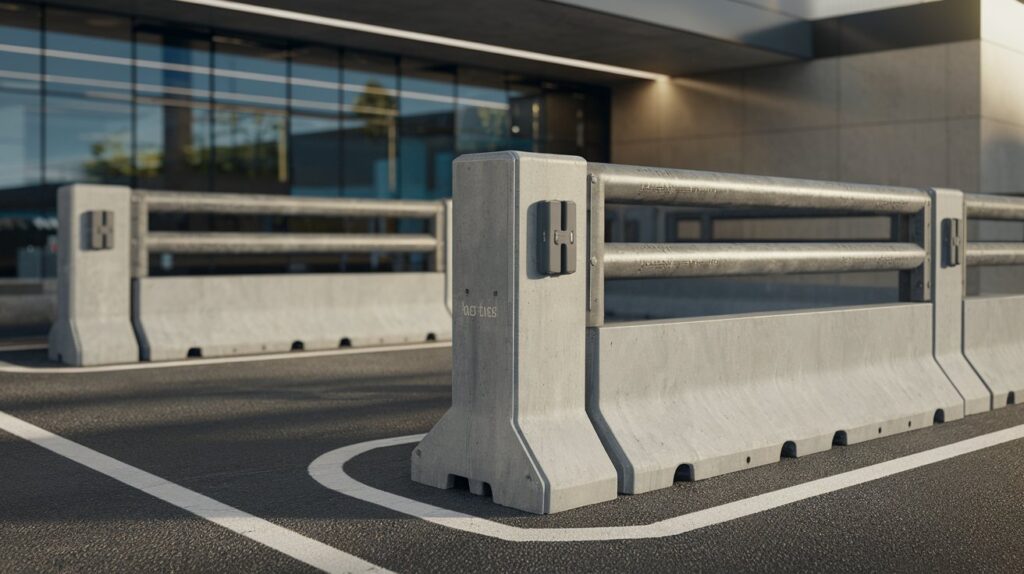Concrete barriers serve as more than simple blocks of cement. They play an important role in protecting property, guiding traffic, and creating safer spaces in both public and private areas. Knowing what features to look for helps make the best choice for long-term safety and performance.
The right barrier can stand up to impact, resist harsh weather, and still remain practical for installation and movement. At the same time, design choices affect how well barriers work in busy areas and how they connect with modern security systems. This article highlights the key features that matter most so the best decision can be made with confidence.
Impact Resistance and Strength
Concrete barriers must stand up to strong forces, especially in areas with heavy traffic or high exposure to vehicles. Their weight and solid design allow them to absorb energy from impact and redirect vehicles away from protected spaces. This helps reduce damage to both property and drivers.
The strength of a barrier depends on its material quality and design. Reinforced concrete and high-performance mixes often provide higher resistance to collisions. These features make them suitable for highways, construction zones, and property protection where safety is a concern.
Different environments call for different levels of strength. Barriers placed near busy roads may need to withstand higher speeds, while those on private property may focus more on durability over time. For buyers looking at long-term protection, concrete barriers by 48 Barriers offer options designed for both impact resistance and lasting strength.
By combining mass, design, and material quality, concrete barriers provide a dependable line of defense against vehicle strikes and other hazards.
Durability Against Weather Conditions
Concrete barriers must hold up against rain, heat, and freezing temperatures. Poor weather can weaken materials over time, so strong mixes and proper design help barriers last longer in outdoor settings.
Exposure to moisture often leads to cracking or surface wear. However, barriers made with dense concrete and quality aggregates resist water better and reduce long-term damage.
In areas with harsh winters, freeze-thaw cycles place pressure on concrete. Barriers with air-entrained mixes handle these cycles more effectively, which helps prevent surface scaling and structural breakdown.
High temperatures can also stress concrete by causing expansion. Therefore, barriers built with the right curing process and reinforcement maintain strength even under direct sun.
Salt and chemical exposure on roads may further affect durability. For this reason, barriers that use protective coatings or additives stand up better against corrosion and surface decay.
Ease of Installation and Mobility
Concrete barriers that install quickly save both time and labor on a project. Crews can place them with standard equipment, which reduces setup delays and keeps work moving forward. This feature makes them practical for sites that require fast deployment.
Mobility also plays an important role. Barriers that can be repositioned allow property owners to adjust layouts as needs change. For example, a barrier may start as a traffic divider and later be shifted to protect a different section of the property.
Temporary barriers often provide the most flexibility. They can be removed or relocated without major effort, making them suitable for short-term projects or areas that require frequent changes. Permanent barriers, by contrast, require more planning before installation.
The balance between ease of installation and mobility depends on the project. A long-term security application may favor heavier units, while a construction site benefits from barriers that crews can move as conditions change. This flexibility helps match safety goals with practical use.
Design for Traffic and Pedestrian Safety
Concrete barriers play an important role in separating vehicles from pedestrian areas. They create a clear boundary that helps reduce conflicts between drivers and people walking near roadways. This separation lowers the chance of accidents in high-traffic zones.
Design features such as height, shape, and surface finish affect how well a barrier protects both drivers and pedestrians. For example, a sloped face can redirect vehicles back toward the roadway, while a smooth surface reduces the chance of snagging or climbing.
Placement also matters. Barriers positioned along sidewalks, medians, or work zones guide traffic flow while giving pedestrians a safer space. Proper spacing allows visibility for drivers without blocking sightlines for those crossing.
Standards and guidelines often recommend designs that balance vehicle control with pedestrian safety. By following these principles, barriers can serve as both protective structures and effective tools for traffic management.
Compatibility with Security Systems
Concrete barriers work best when they connect with other security tools. They can be set up alongside gates, bollards, or access control systems to create a stronger line of defense. This makes them more than just physical blocks.
A barrier that fits with cameras or sensors allows property owners to track movement and respond faster. For example, barriers near entry points can limit vehicle access while cameras record activity. This combination supports both safety and monitoring needs.
In addition, barriers can be designed to match the layout of electronic systems. Proper planning helps prevent gaps that intruders could exploit. Placement should allow smooth coordination between physical barriers and technology.
Properties with higher risk often need layered protection. Concrete barriers that integrate with alarms or monitoring stations provide a clear advantage. This setup helps security staff act quickly while the barriers slow down unwanted access.
Compatibility makes barriers more effective because they work as part of a complete security plan rather than standing alone.
Conclusion
Concrete barriers give property owners a strong and practical way to manage safety and security. Their strength, durability, and ability to control movement make them a dependable choice for many environments.
They not only protect against vehicle impact but also help guide traffic and create safer spaces for pedestrians and workers. This makes them useful in both permanent and temporary setups.
By focusing on features such as strength, design, placement, and flexibility, property managers can choose barriers that meet both safety and functional needs. This careful selection supports long-term protection and efficient site management.

